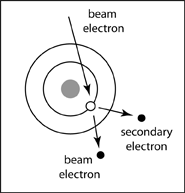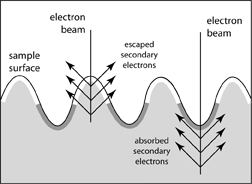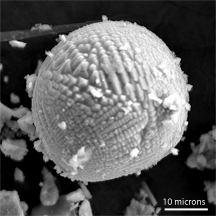|
How are secondary electrons formed? Secondary electrons are low energy electrons that are emitted from the sample as a result of interactions between the beam electrons and the electron shells of the sample. Most secondary electrons are produced through the process of a high energy beam electron knocking an orbital electron out of its shell. This freed orbital electron can now escape from the sample surface. However, because the energy of the secondary electron is so low (by definition they are electrons with less than 50 eV of energy), its mean free path is very short; and therefore it has a high probability of colliding with other orbital electrons before it goes very far. As a result it will lose its energy and be absorbed by the sample. This means that secondary electrons can only escape from the sample if they are produced very close to the sample surface. The escape depth of a secondary electron is only 5 nm for a conductor and 50 nm for an insulator. |
 |
|
What do secondary electrons tell us about the sample? Because secondary electrons are very low-energy and can only escape if produced very near the surface, they give us information about the surface morphology and/or textures. Depressions in the sample will not allow as many secondary electrons to escape as a ridge will. Therefore, a secondary electron image will highlight these features. |
|

